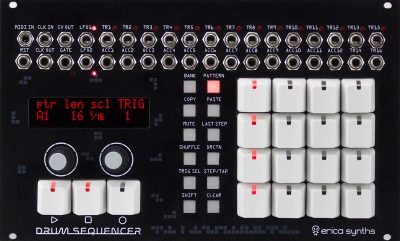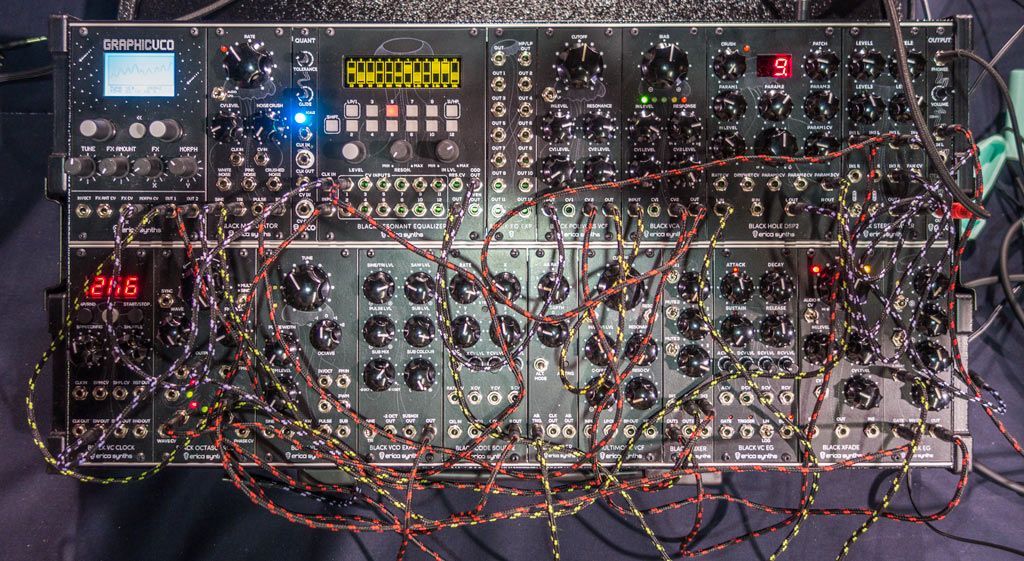One of the most talked about new modules at NAMM was the Frap Tools Fumana Dual 16 Bands Spectral Editor. It is from the same school of thought as the Buchla 296 Spectral Processor, and the Verbos Bark Filter Processor which came out last year and which I already created a set of videos for. Erica Synths also showed a preliminary version of their upcoming Resonant Equalizer which also covers some of the same territory. So let’s talk about all of those, and then move on to the subject of semi-modular synths (which were also hot at NAMM).
Frap Tools
Their big new module this NAMM was the Fumana ($999), which contains two sets of 16 bandpass filters. One set analyzes the incoming Modulation signal and applies an envelope follower to each band, outputting a resulting control voltage per band (an “all” CV output is also available; master attack and decay controls are also available). A second set of 16 filters is used to split up and process the Main signal. You have access to the direct audio output for each of these bands. You can also split the Fumana into Odd and Even halves, with separate inputs and outputs. This means you can treat it as a pair of dual 8-band processors, as well.
There is a VCA assigned to each of these Main bands, which can be controlled by a manual slider for each band, a CV input for each band, the Modulation envelope followers, and a set of macro “spectral editing” controls. These controls allow you to “tilt” the frequency balance – emphasizing the highs while cutting the lows, or vice versa. They can also create a “parametric” scan where you set the center frequency and width of which bands are boosted. These spectral editing controls have both front panel knobs and voltage control inputs.
Users inevitably ask, “How is this different than the Verbos Bark Filter Processor?” The very short answer is “The Fumana has more bands, is bigger, and costs more” – but it goes well beyond that. The Bark Filter uses 10 bandpass filters with 36dB/octave slopes plus high and low pass bands on the ends with a signature resonant sound, coloring signals even when all of the bands are full on. The Bark also spaces out those bands based on the perception-based Bark Frequency Scale so a particular pitch or musical key is not emphasized over another. Overall, the Bark Filter has a very characteristic sound more reminiscent of a resonant filter bank.
The Fumana, by contrast, uses 16 bandpass filters with 48dB/octave slopes and a very transparent, uncolored sound. Indeed, early on in the design of Fumana, Frap Tools changed from Butterworth to Bessel filter topology to minimize the phase shift and coloration. The spacing between bands 2 through 15 is 5.5 semitones per pair (2 bands = a major 7th, which is also used by the Serge Resonant Equalizer), also to make sure a particularly frequency like 60Hz and its harmonics is not favored over the others. Bands 1 and 16 have been placed at the very edges of audibility to treat sub-bass as well as high-frequency “air.” The result is the Fumana sounds more like a high-end pro audio EQ – indeed, it is so smooth that its global center and width controls truly allow you to treat as a parametric EQ as well as a graphic equalizer it looks like.
Where the Fumana really separates itself is when used as a vocoder: The Bark Filter has to use half (six) of its bands for analysis, and then the remaining six bands to modify a sound; Fumana has 16 analysis bands as well as an additional 16 bands to process the signal. Fumana also has a separate “unvoiced” input for the noise components of sounds, controlled by the strength of the signal in analysis bands 14 & 15.
I already have a Fumana, and will absolutely be creating videos on it after I have spent more time learning it (and after I clear out a bunch of other projects).
Erica Synths
Erica had a large number of new modules at NAMM; let’s start with the one closest to the Fumana since we’re on that particular roll, and then branch out.
The Erica Black Resonant Equalizer (due in May; no price yet) is a 12-band unit like the Verbos Bark Filter – 10 bandpass filters plus a high pass and low pass at the ends – with a digital OLED display rather than the sliders of both the Bark and Fumana. But don’t let the digital display and patch recall fool you; it’s analog inside with swappable filter boards. The first one has its bands spaced 9 semitones apart (again, to avoid reinforcing a particular musical key); other spacings and filter designs are planned in the future. Like the Bark and Fumana, it has CV in per channel, but does not have their envelope follower outputs. The Black Resonant also features a Resonance control (it excelled at highly colored, overdriven sounds), and a clock in to step through the bands. The Black Resonant does not feature individual outputs per band; just a mono “all summed” plus even/odd summed outputs.
A popular module at the show was the Erica Graphic VCO (due this month for €330 + VAT), which had been previewed as far back as 2015 but will finally ship by the end of this month. It has a wide variety of algorithms, many centered around crossfading (morphing) between different waveforms or wavetables. These waves are higher resolution than normal, featuring 1024 points with a 96 kHz sample rate. You get to select those waves, arrange them in banks and wavetables, and visually edit using a number of tools. It also supported traditional 2D wavetable navigation, FM, ring modulation, bit crushing, wavefolding, and a sub-oscillator that outputs a variation on the sound you are working with, along with a nice assortment of CV inputs and an internal, syncable LFO.
Also new was the redesigned Black Hole DSP2 (due in April; no price yet). The updated version comes with 24 effects, analog wet/dry crossfade, 3 voltage-controllable parameters per effect (the initial settings of which can be saved with a preset), and the addition of a Crush feature that can reduce the sample rate as low as 1 kHz.

Pittsburgh (Semi-)Modular
Pittsburgh has released a few “full voice” modules in the past; this NAMM they surprised by showing the Microvolt 3900 ($629): a small tabletop semi-modular synth in the vein of the popular Make Noise 0-Coast. Indeed, I think it went even further toward capturing an “East plus West” vibe than the 0-Coast with good plucks plus sustained tones, sounding very animated and full – especially for a one VCO synth. The Microvolt’s feature set reinforces this: Its oscillator has not just a square wave with PWM, but also a sine wave with a wave folder; it also features a rectifier (creates even harmonics for an octave sound), their state-variable Binary Filter, an LPG based on their Dynamic Impulse Filter, a shift register based random LFO shape, and Output Drive. It supports MIDI, has an arpeggiator built in, and also features a 35-point patchbay plus a patchable utility mixer. Keep an ear on this one; I really liked its twang.
More Semi-Modulars
The Microvolt was one of several semi-modular synths announced at or during the show. One module I missed at the show that everyone else was talking about was the 68hp Radikal Technologies Delta CEP A (price to be confirmed; I heard $999). It is an analog/digital hybrid, featuring a digital “swarm” oscillator (up to eight oscillators that can be detuned for fat dubstep sounds or pre-tuned to form chords or tone clusters – essentially half their RT-311 Swarm Oscillator Eurorack module), supposedly both an analog and a digital filter (only one is apparent from the front panel – regardless, it apparently sounded very good), an FX section including tape delay emulation, well-integrated MIDI, and a number of patch points.
Meanwhile, NAMM non-exhibitor Behringer announced their bright red 84hp Neutron semi-modular synth (at the ridiculously low price of $299.99). It ticks a lot of boxes with 2 Curtis-clone 3340 VCOs, a new two-pole filter of their own design, two envelopes, overdrive, a BBD delay, utility module sections like a slew limiter, attenuator, and sample & hold, and a surprising 56-point patchbay. Although it’s not yet mentioned on the “keyboards” page of the Behringer web site as of the time this was written, they say it’s going to ship in April; pre-order pages on some retailer sites appeared briefly then disappeared.
In addition to these and the Malekko Manther Growl previously mentioned, there was also an interesting semi-modular from SSF called the Bantam – so maybe that’s where I’ll start the next installment…




